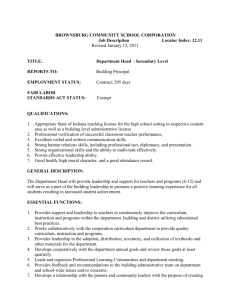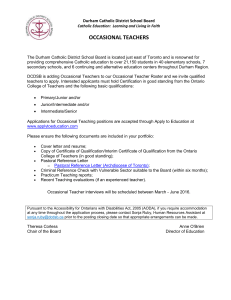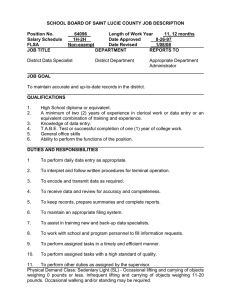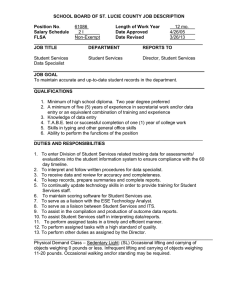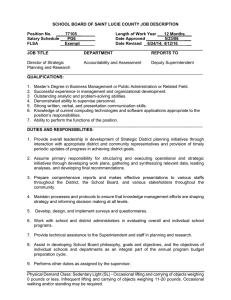occasional flexibility: Small Request; Big Impact bo
advertisement
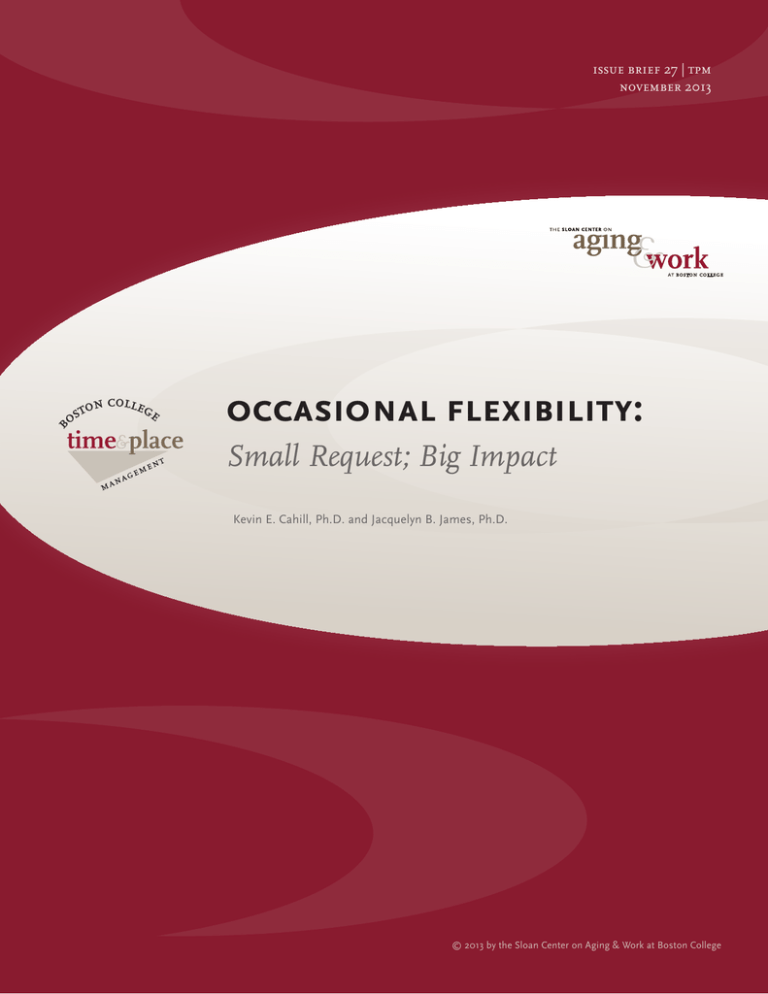
issue brief 27 | tpm november 2013 b issue brief 27 | tpm november 2013 colleg ton e s o occasional flexibility: Small Request; Big Impact Kevin E. Cahill, Ph.D. and Jacquelyn B. James, Ph.D. agework@bc.edu 1 © 2013 by the Sloan Center on Aging & Work at Boston College introduction In 2012, the Copenhagen Consensus Center organized a panel of leading economists to list in order of priority the most cost-effective ways to advance global welfare. What might one expect to see at the top of such a list? Tackle climate change? Extend protected wildlife areas? Work to reduce heart attacks? No to all three. The top contender: reducing undernutrition in preschoolers (Table 1). The economists estimate that the financial benefits of bundled interventions to reduce undernutrition in preschoolers are 30 times greater than the cost. That is, each dollar spent to combat undernutrition in preschoolers has an estimated payoff of 30 dollars. Table 1. Prioritized List of Global Challenges and Solutions Rank Challenge Solution 1 Hunger and education Bundled interventions to reduce undernutrition in preschoolers 2 Infectious disease Subsidy for malaria combination treatment 3 Infectious disease Expanding childhood immunization coverage 4 Infectious disease Deworming of school children 5 Infectious disease Expanding tuberculosis treatment 12 Climate change Geo-engineering R&D 17 Climate change Increased funding for green energy R&D 19 Chronic disease Heart attack risk reduction generic pill 28 Biodiversity Extension of protected areas Notes: [1] The question posed to the panel was, “What are the best ways of advancing global welfare, and particularly the welfare of developing countres, illustrated by supposing that an additional $75 billion of resources were at their disposal over a 4-year initial period?” Source: Copenhagen Consensus 2012, http://www.copenhagenconsensus.com/sites/default/files/Outcome_Document_Updated_1105.pdf/. The same cost-benefit logic also applies to improvements in the workplace. When employers think about raising productivity and morale, they tend to consider largescale innovations in the way the organization does its business or wholesale revision of human resources policies. Yet the biggest return on investment might come from approving those infrequent requests that employees make to have a few hours off to do something with or for their families. Take, for example, the case of a hospital worker at ModernMedical—a large regional medical provider in the United States. The worker had demonstrated time and again her commitment to her patients and to the organization, logging extra hours whenever she was asked to do so. Then, her circumstances changed and the balance she had 2 http://www.bc.edu/agingandwork issue brief 27 | tpm november 2013 struck between her work life and her personal life—her “work/life fit equation”— evolved. She was asked to join the board of her child’s school, which she very much wanted to do, but every so often the position required her to attend meetings on weeknights. The board meetings would still allow her to meet all of her ModernMedical responsibilities comfortably. What she needed, however, was a commitment from her employer not to insist that she work on nights when she was expected to attend board meetings. Obtaining that commitment was a challenge for her. This worker’s situation highlights the tension that can be associated with requests for occasional flexibility. What may seem like a small request from an organization’s perspective can have a profound effect on the life of an employee. In recent years, the Sloan Center on Aging & Work has produced dozens of issue briefs, each one exploring a single age/work-related question in depth. This one focuses on how flexible scheduling can have very little to do with planned deviations from routine days of the week or times of the day worked and a lot to do with occasional flexibility. Researchers at the Sloan Center are conducting a pioneering effort to design, implement, and assess the effectiveness of a next-generation time and place management (TPM) initiative. As part of this study, the research team is surveying managers and employees at ModernMedical to assess the personal and business impact of changes in TPM. The survey is longitudinal and ongoing, but results from the baseline ModernMedical survey are informative. The relationship between schedule matches, work/life balance, and occasional flexibility At ModernMedical, 82 percent of employees and 98 percent of managers report that their typical days of the week worked (weekdays; weekends; both weekdays and weekends) match their ideal days of the week to work (Figure 1). Moreover, 92 percent of employees and 85 percent of managers report that their typical hours worked (days; evenings; nights) match their ideal hours to work. So, for the most part, employees and managers have schedules that fit their preferences. At the same time, like many organizations, ModernMedical is striving to achieve better work-life fit—satisfaction with one’s ability to be productive both on and off the job—among its employees. When asked whether ModernMedical supports employees’ ability to balance work with their lives outside of work, a sizable minority of both employees and managers responded negatively. Nearly 20 percent of employees and one quarter of managers say they either “strongly disagree” or “disagree” that ModernMedical supports work/life balance, and another quarter of employees and managers say they are “neutral” (Figure 2). Less than 20 percent of employees and managers say they “strongly agree.” The pattern of these two findings—1) employees and managers by and large are working the days and hours they prefer to work, and 2) employees and managers report lower-than-average support for work/life balance—persists in the domain of occasional flexibility. agework@bc.edu 3 Figure 1. Match Rate between Typical and Ideal Work Schedules, Employees and Managers 98 100% 92 85 Percentage of respondents 82 Employees 80% Managers 60% 40% 20% 0% Days Time of day Notes: [1] Days worked response options are: weekdays, weekends, and both. Time of day response options are: day, afternoon-evening, and night. [2] The match rate between typical and ideal time of day worked is based on responses from 2,928 employees and 318 managers. The match rate between typical and ideal days worked is based on responses from 2,924 employees and 317 managers. Source: The Boston College Study of ModernMedical’s Health System, Pilot TPM Initiative Baseline Survey. Figure 2. Perceptions of Organizational Support for Work-life Balance, Employees and Managers 40% 38 Employees 35 Percentage of respondents Managers 30% 25 26 19 20% 18 13 10% 0% 6 13 6 Strongly disagree Disagree Neutral Agree Strongly agree Perception of organizational support for work-life balance Notes: [1] Based on the question: “To what extent do you agree or disagree with the following statement: [ModernMedical] supports me in balancing my work life and personal life?” [2] Work-life balance is based on responses from 2,928 employees and 319 managers. Source: The Boston College Study of ModernMedical’s Health System, Pilot TPM Initiative Baseline Survey. 4 http://www.bc.edu/agingandwork One way to define occasional flexibility is the ability to take a few hours off during regularly scheduled hours for personal reasons. Using this definition, we found clear evidence that occasional flexibility is important to ModernMedical employees and managers. The majority of ModernMedical employees report that occasional flexibility is either “very important” (48 percent) or “moderately important” (24 percent) (Figure 3). Among managers, 53 percent described occasional flexibility as “very important” and 29 percent described it as “moderately important.” Figure 3. Importance of Occasional Flexibility, Employees and Managers 60% Employees 53 48 Managers 50% Percentage of respondents issue brief 27 | tpm november 2013 40% 29 30% 24 21 17 20% 10% 7 1 0% Unimportant Somewhat important Moderately important Very important Notes: [1] Based on the question: “How important is it to you to be able to occasionally take a few hours off during your regularly scheduled hours for personal reasons?” [2] The importance of occasional flexibility is based on 2,925 employee responses and 318 manager responses. Source: The Boston College Study of ModernMedical’s Health System, Pilot TPM Initiative Baseline Survey. When we asked employees how often they actually requested occasional flexibility, however, the figures were low: 49 percent of employees and 55 percent of managers said they had asked for time off once or twice during the previous two months and 35 percent of employees and 13 percent of managers had not asked at all (Figure 4). Although it is possible that employees had not needed to make such requests over the previous two months, another plausible explanation is that they hesitated to ask. Indeed, less than 40 percent of ModernMedical employees and 64 percent of managers were “completely comfortable” requesting a few hours off during regularly scheduled hours (Figure 5). Another explanation is that employees and managers make adjustments on the family side of the equation to avoid asking their bosses for adjustments on the work side. Such sidestepping does not show up in the data, so researchers cannot easily document it. agework@bc.edu 5 Figure 4. Number of Requests for Occasional Flexibility in the Past 2 Months, Employees and Managers Percentage of respondents 60% 55 49 50% 40% Employees 35 Managers 30% 23 20% 13 12 10% 0% 3 Not once 1-2 times 3-4 times 4 5-6 times 1 3 3 0 7-8 times 9 times or more Notes: [1] Based on the question: “Over the past 2 months, how many times did you take a few hours off to accommodate personal needs?” [2] The number of requests for occasional flexibility is based on 2,927 employee responses and 318 manager responses. Source: The Boston College Study of ModernMedical’s Health System, Pilot TPM Initiative Baseline Survey. Figure 5. Comfort with Making a Request for a Few Hours Off, Employees and Managers 70% 64 Percentage of respondents 60% Employees 50% 38 40% Managers 30% 20% 10% 0% 22 21 19 19 12 4 Not at all comfortable Somewhat Moderately Completely comfortable comfortable comfortable Notes: [1] Based on the question: “To what extent do you feel comfortable making a request for a few hours off during your regularly scheduled hours?” [2] Comfort with making a request for a few hours off is based on 2,923 employee responses and 318 manager responses. Source: The Boston College Study of ModernMedical’s Health System, Pilot TPM Initiative Baseline Survey. 6 http://www.bc.edu/agingandwork Even in the absence of data, conceptually it is easy to see how certain outcomes are suboptimal, where optimal is defined as the combined benefits to the employee and manager outweighing the combined costs to the employee and manager. A straightforward illustration of a cost-benefit approach to a hypothetical situation highlights the point (Figure 6). The employee’s benefit of being granted occasional flexibility might be enormous. For example, the benefit to a parent who requests occasional flexibility to see a child perform in a one-night-only school play could be extremely valuable. The cost to the manager—in terms of time spent coordinating schedules, for example—is certainly real, but in our example it is assumed to be small relative to the employee’s benefit. In this case, the decision to approve such requests is unambiguous if someone were to weigh the benefits to the employee against the costs to the employer. In contrast, from the manager’s perspective, the benefits to the employee might either not be taken into account at all, or might be heavily discounted. The second panel of Figure 6 illustrates the same cost-benefit decision from the perspective of the manager. The outcome is then the opposite of the ideal outcome: the request for occasional time off is denied. Cost to the manager / benefit to the employee Figure 6. An Illustration of a Cost-Benefit Approach to a Hypothetical Request for Occasional Flexibility Cost to the manager / benefit to the employee issue brief 27 | tpm november 2013 Social Planner’s Perspective Benefit to the employee Cost to the manager Work Unit Manager's Perspective Cost to the manager Benefit to the employee agework@bc.edu 7 The value of communication When cost/benefit calculations are clear—that is, when total benefits exceed total costs—how can organizations prevent suboptimal outcomes? Economists sometimes refer to this problem as an externality. In the case shown in the bottom panel of Figure 6, the full benefit to the employee is not taken into account by the decision maker (the manager). One way to solve the externality problem is to find ways to incorporate the employee’s benefit in the manager’s decision. Open communication is one straightforward way to help ensure that managers take into account the employee’s benefit when they consider requests for occasional flexibility. After all, the height of the gray bar in Figure 6 is unknown to the manager unless the employee relays this information accurately. The need for full information is not an issue of concern only to a manager, for that matter. Just as it is critical for a manager to understand the magnitude of the benefit of occasional time off to an employee, an employee needs to understand the costs that a manager associates with such requests. The employee’s understanding of the height of the red bar in Figure 6 will be some comfort when requests are denied, as they inevitably will be from time to time. Indeed, employees and managers at ModernMedical appear to understand that managers must yield to circumstance and cannot always approve requests for time off. Both employees and managers report widespread support among coworkers and supervisors for requests for occasional flexibility. In fact, more than eight out of ten ModernMedical employees say that their supervisor is either “supportive” or “very supportive” of occasional flexibility (Figure 7). The level of support for occasional flexibility that employees perceive from their coworkers is even higher. The finding of supervisor and coworker support for occasional flexibility, along with a low incidence of requests for occasional flexibility, introduces an important third dimension that could either hinder or promote optimal outcomes: the organization and its policies on occasional flexibility. Our discussion to this point has assumed that managers and employees are free to work out an arrangement with respect to hours worked at the prevailing wage. For whatever reason—be it a concern about equity across the workforce or some other organizational policy constraint—an institution may have very good reasons for keeping a tight rein on the number of hours worked or on total wages paid to individuals during a pay period. One way to visualize the impact of institutional constraints on decisions by employees and their managers is shown in Figure 8. The horizontal axes in both graphs denote the requested number of hours off by an employee and the vertical axes denote total wages (hours worked multiplied by hourly wage). The curved lines are what economists call indifference curves. At all points along each indifference curve an employee is equally satisfied. In this case, the indifference curves refer to the trade-off between hours off and total wages. The diagonal line represents the options available to the employee (and manager), and the dotted portion of the diagonal line represents an option that is not available. The top panel shows a situation where the employee would prefer to work fewer hours but a constraint prevents her from doing so. Constraints can also work in the other direction. The bottom panel shows a situation where the employee prefers to work more hours–say, to accommodate an expected 8 http://www.bc.edu/agingandwork Figure 7. Supervisor and Coworker Support for Occasional Flexibility, Employees and Managers Supervisor Support 69 Percentage of respondents 70% 60% Employees 50% 30% 26 20% 10% Managers 43 39 40% 0% 12 6 3 2 Very Unsupportive Supportive unsupportive Very supportive Coworker Support 70% Percentage of respondents issue brief 27 | tpm november 2013 62 60% Employees 50% 45 40% 44 Managers 32 30% 20% 10% 0% 4 8 1 4 Very Unsupportive Supportive unsupportive Very supportive Notes: [1] Based on the question: “How would you describe the typical response to your requests to take a few hours off during your regular scheduled hours for personal reasons from the following people (supervisor; coworkers)?” [2] Supervisor (coworker) support for occasional flexibility is based on responses from 2,909 (2,900) employees and 316 (317) managers. Source: The Boston College Study of ModernMedical’s Health System, Pilot TPM Initiative Baseline Survey. agework@bc.edu 9 Figure 8. An Illustration of the Work-leisure Decision, with Work and Hour Constraints Case 1: Leisure hours are constrained Total wages L* = maximum hours of leisure allowed Actual outcome Preferred outcome L* Hours of leisure Case 2: Total earned wages are constrained Total wages Preferred outcome Actual outcome W* W* = maximum wages allowed Hours of leisure 10 http://www.bc.edu/agingandwork issue brief 27 | tpm november 2013 request in a subsequent pay period–but a wage restriction, such as overtime, restricts that possibility. In both cases, the institutional constraint prevents the employee and manager from achieving an optimal outcome from the perspective of the employee and manager. While such constraints may lead to suboptimal outcomes at the manager/employee level, the outcome may be optimal for the organization as a whole. Equity, such as the promotion of a culture of equal treatment of all employees, as noted above, is a good example of such an ultimately optimal outcome. An important question, then, is what institutional constraints on the decisions of employees and managers are justified? That is, when are the suboptimal outcomes for employees or managers outweighed by the benefits to the organization as a whole? That discussion is well beyond the scope of this brief. One response, however, is the importance of communication in the process. Just as employees and managers need to communicate with one another, organizations benefit when administrators communicate to employees and managers, helping them to understand why an apparently reasonable solution that they have devised at the work-unit level cannot be implemented. Finally, a little perspective about what is at stake might aid discussion about the importance of occasional flexibility. The relationship of an employer with employees is complex. A mutually-agreeable arrangement needs to be found with respect to many requirements: salary/wage, hours worked, days worked, and shifts worked. Then there are the intangibles: Is the prospective employee a good fit for the culture of the organization; will the employee be reliable; will the employee be a net asset or a liability? When there is a match, employer and employee alike have an interest in maintaining it. This is where requests for occasional flexibility come in. With so much at stake in their relationship, both employers and employees stand to gain from making occasional flexibility a reality. One obstacle to the achievement of optimal outcomes is managers’ failure to take into account the full benefits to employees of occasional flexibility. In this situation, managers deny requests for time off unjustifiably. Another obstacle is employees’ failure to comprehend the full costs of occasional flexibility to their managers. In this situation, employees can feel frustrated even though the denial of their requests is justified. Both situations are suboptimal and can be avoided with a solid partnership between managers and employees built on open communication. As discussed in this brief, the biggest bang for the buck in the realm of workplace flexibility may come from improving the process that employees use to request time off. Our discussions with employees as part of the discovery process and the findings from our comprehensive baseline survey tell us that employees at ModernMedical place a high value on their freedom to make occasional requests for time off. Accommodating these requests, which may seem minor to a manager or to an organization, can have an enormous impact on employees and their families. The outcome of a request can be the difference between whether an employee can or cannot attend their child’s holiday play, and have an experience whose memory will last forever. The loyalty the employer receives in return just might last forever, too. agework@bc.edu 11 about the sloan center on aging & work Established in 2005, the Sloan Center on Aging & Work at Boston College promotes quality of employment as an imperative for the 21st century multi-generational workforce. We integrate evidence from research with insights from workplace experiences to inform innovative organizational decision-making. Collaborating with business leaders and scholars in a multi-disciplinary dialogue, the center develops the next generation of knowledge and talent management. Since our founding, we have conducted more than 20 studies in collaboration with employers: for example, studies on “Age & Generations,” “Talent Management,” and “Generations of Talent.” Studies under way are “Assessing the Impact of Time and Place Management” and “Engaged as We Age.” The Sloan Center on Aging & Work is grateful for the continued support of the Alfred P. Sloan Foundation. Sloan Center publications are sponsored in part by CVS Caremark. For more information about the Center, please visit: http://www.bc.edu/agingandwork Contact us: Sloan Center on Aging & Work 140 Commonwealth Avenue–3 Lake Street Building Chestnut Hill, MA 02467 Phone: 617.552.9195 • Fax: 617.552.9202 agework@bc.edu Authors Kevin E. Cahill, Ph.D. is a research economist at the Sloan Center on Aging and Work. His current projects examine patterns of labor force withdrawal, including bridge job employment, phased retirement, and re-entry. Kevin earned his B.A. in mathematics and economics (with honors) from Rutgers College and his M.A. and Ph.D. in economics from Boston College. Jacquelyn B. James, Ph.D. is research director at the Sloan Center on Aging & Work and research professor in the Lynch School of Education at Boston College. She is co-author (with Fredric R. Van Deusen, Nadia Gill, and Sharon P. McKechnie) of Overcoming the Implementation Gap: How 20 Leading Companies are Making Flexibility Work (Boston College Center for Work & Family; 2007). 12 http://www.bc.edu/agingandwork
